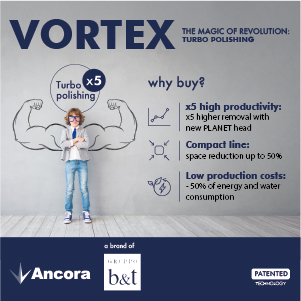The 2020 results of the Spanish glaze and colour producers

Turnover totalled €1,256 million (down 5.3% on 2019), of which 70.5% was generated by exports (-5.9%). The Spanish market recovered more quickly, closing 2020 at -3.7%.
Thanks to an initial recovery in the third quarter of 2020 followed by even stronger growth in the fourth quarter, the Spanish ceramic frit, glaze and colour industry was able to close the 2020 financial year with a much smaller loss in revenues than business leaders had been fearing in early summer.
According to trade association ANFFECC, the industry’s 2020 sales revenues totalled €1,256 million, 5.3% down on 2019. This nonetheless marked a significant recovery compared to the first half of the year considering that the lockdown caused a 37% fall in sales in the second quarter of 2020 with respect to the same period in 2019.
Exports suffered the biggest losses, falling to €885 million in 2020 (down 5.9% on 2019) and accounting for 70.5% of the Spanish glaze and colour producers’ total revenues.
Domestic sales (€371 million, or 29.5% of the total) recovered more rapidly in step with the strong recovery of the Spanish ceramic industry, limiting the decline in revenue to just -3.7%.
According to ICEX data, Italy remained the largest foreign market despite a 3.5% drop in sales. Next came Algeria, where the Spanish glaze and colour producers’ exports grew by 11% and recovered from the negative effects of the import ban imposed a year ago. The third largest export market was India despite a 10.4% decline in sales, followed by China and Turkey with double-digit growth of +10.4% and +29.3% respectively compared to 2019.
ANFFECC Secretary General Manuel Breva notes that the negative result in 2020 was to be expected given the impact of the pandemic on the national and international economy. “Despite this situation, in the second half of the year we managed to gradually recover our sales volumes and the industry now expects to continue at this pace, unless the third wave of the pandemic causes a further deterioration in the health situation,” he said.
Industry representatives have reminded the government of the importance of European funding and aid for injecting liquidity into the economy and enabling industrial activities to continue. With the decline in tourism, this sector remains one of the main generators of value and employment in the Castellón ceramic district. Outstanding issues still facing entrepreneurs include the risk of an increase in the tax burden on companies, the excessively high cost of gas and the fear of potential increases in raw materials prices, which Spanish glaze and colour producers would find hard to absorb and in some cases are already showing signs of volatility.
Did you find this article useful?
Join the CWW community to receive the most important news from the global ceramic industry every two weeks
























